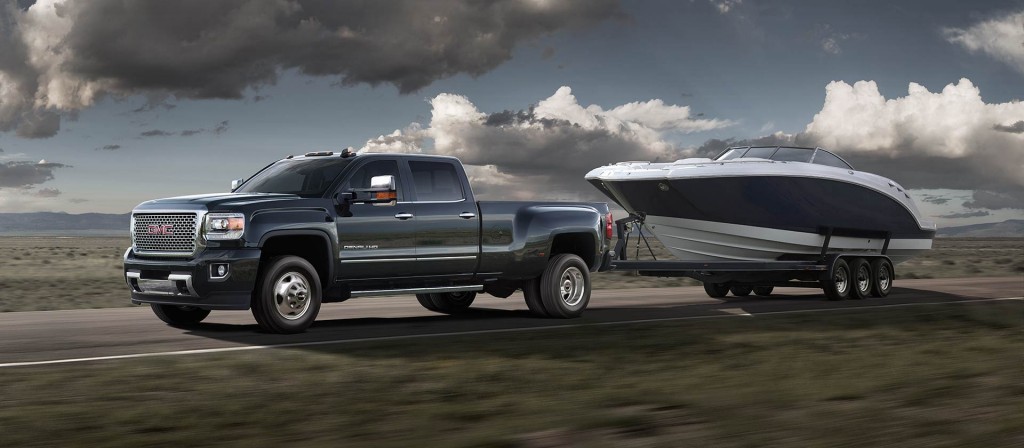They make towing possible. From a utility standpoint, they may be the most useful and important truck accessory available.
Hitches. That all-important link connecting your truck and trailer.
The hitch is the unsung hero of racing weekends at the track, boating weekends at the lake, start-up lawn care companies, travelling show car owners, and the million other things made possible by a good hitch paired with a worthy hauler.
Here are some things you might need to know about choosing a new hitch for your truck or SUV.
How to Choose a Hitch and Tow Safely
1. Choose a Receiver Hitch (unless you require heavy-duty towing equipment)
The first thing you’ll need is a receiver hitch. It’s a bar of steel you bolt on to your tow vehicle, and generally features a square-shaped opening, or collar, designed to “receive” hitch ball mounts and other implements.
Receiver hitches are rated by class. Classes indicate safe weight carrying capacities for particular hitches. That weight is determined by two factors. One is Gross Trailer Weight (GTW)—the total weight of a trailer and its cargo. The other is Tongue Weight (TW)—the downward force placed on the hitch ball by the trailer’s coupler. Tongue weight is usually 10 to 15 percent of GTW.
Standard hitch classes and load ratings:
Class 1: 1,000 to 2,500 lbs. GTW, 200 lbs. TW
Class 2: 3,500 lbs. GTW, 300 lbs. TW
Class 2.5: 4,000 lbs. GTW, 400 lbs. TW
Class 3: 6,000 lbs. GTW, 350-600 lbs. TW
Class 4: 8,000 lbs. GTW, 800 lbs. TW
Class 5: 10,000 lbs. GTW, 1,000 lbs. TW
Standard receiver hitches and bumper hitches serve as weight-carrying hitches because the hitch ball and mount is carrying all of the trailer’s tongue weight. Too much will force your tow vehicle’s rear end down, in turn, lifting the front end, which would result in an imbalanced, unstable ride. You solve that problem with weight distribution hitches, which utilize long spring bars to transfer weight more evenly to your tow vehicle’s frame, which enhances stability and allows you to tow heavier loads.
Heavy-Duty Towing
The most common hitch solutions for heavy-duty towing are fifth-wheel hitches and gooseneck hitches.
Fifth-wheel hitches incorporate the setup used by semi-trucks to distribute weight over the tow vehicle’s axles and achieve tighter turns by mounting to rails installed in your truck bed.
Gooseneck hitches also help you achieve heavier towing capabilities, due to the hitch ball being anchored in the center of your tow vehicle’s truck bed.
2. Choose Your Towing Accessories
Hitch Balls and Mounts
The hitch ball is the physical connection between the tow vehicle and the trailer. It threads into the ball mount and is secured with a nut. Hitch balls are available in many diameters to fit various ball sockets on trailer couplers.
Ball mounts have a square tube shank that fits in the receiver hitch’s collar and is secured with a steel pin. They are available with different ball mounting pad heights. To keep the trailer and tow vehicle level with one another, you must be precise when setting your mounting height.
Hitch balls and mounts are rated by load capacity. Always use components rated at or above the load you are towing.
Safety Chains
Safety chains are used to keep the trailer secured to the tow vehicle if the coupler separates from the hitch. Two chains are used, which should cross one another under the trailer tongue so it doesn’t hit the ground. The chains should have enough slack so the tow vehicle can make turns. The chains must be attached to the receiver hitch or vehicle frame, and never to the bumper.
Like receiver hitches, chains are also rated by capacity; in this case, according to the minimum breaking force:
Class 1 Trailer: 2,000 lbs. breaking force
Class 2 Trailer: 3,500 lbs. breaking force
Class 3 Trailer: 5,000 lbs. breaking force
Class 4 Trailer: must have a minimum breaking force equal to or exceeding the Gross Vehicle Weight (GVW) of the trailer
Trailer Tires
Don’t skimp on tires for your tow vehicle or trailer. They need to be rated for the load you plan to tow—loading a trailer beyond the tire rating could cause tire failure. Make sure your trailer tires are properly inflated to minimize trailer sway.
Trailer Brakes
While many small trailers can be controlled using your tow vehicle’s brakes, larger trailers will require a brake controller to activate your trailer brakes to work safely and in conjunction with your truck brakes.
Trailer Hitch Wiring
In order to get your trailer’s taillights, brake lights, and turn signals to work properly, you will need to wire it to your tow vehicle. Trailer hitch and brake controller wiring harnesses are available to make this an easy job.
Other Accessories
There are all kinds of other accessories that pair nicely with your vehicle’s receiver hitch, including hitch covers to keep dirt out of your receiver hitch when it’s not in use, hitch pins that are critical to keeping ball mounts attached to your vehicle, and other great tools like cargo carriers, bike racks, and hitch steps, which make nice additions to your truck when you’re not towing a trailer.


Comments